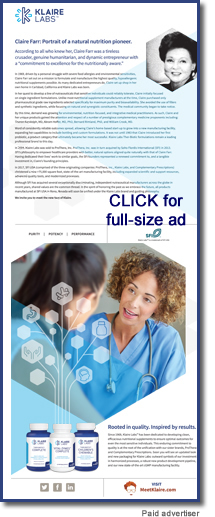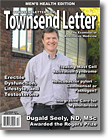|
Parts 1 and 2 are online here.
Part 3 is also online.
Page 1, 2
Adverse Effects, Drug Interactions, and Contraindications
In reviewing 31 medical marijuana trials, Borgelt, et al noted that researchers reported 4,779 adverse events in patients receiving a medicinal cannabinoid for 8 to 12 months. Of these, 96.6 percent events were not serious (most common: dizziness - 15.5%). There were 164 serious events, the most common being multiple sclerosis relapse (12.8% of the events), vomiting (9.8% of the events), and urinary tract infection (19.1% of the events).1
Other mild-to-moderate adverse effects included "somnolence, ataxia, blurred vision, headache, dry mouth, sedation, dizziness, conjunctival irritation/dry eyes, hypotension, feeling intoxicated, nausea, and difficulty with concentration and/or memory." Most of the reported adverse effects are typically not serious, with the most common being dizziness.1
 Townsend Letter provides a platform for those examining and reporting on functional and integrative medicine. Please support these independent voices. Townsend Letter provides a platform for those examining and reporting on functional and integrative medicine. Please support these independent voices. |
But, what of the effect of exogenous (outside) cannabinoids on the brain?
A study by Giovanni Battistella, et al investigated brain structure changes in a group that smoked cannabis on a regular basis and a group that smoked it only occasionally. All subjects were between the ages of 19 and 21, had no psychiatric disorders, used only cannabis – no other drugs, and were split into two groups based on age of first cannabis use, in order for the investigative team to evaluate effect of cannabis on the developing brain2:
In normal adolescents the volume of cerebellar gray matter starts to decrease around puberty and continues to do so until early adulthood … (probably) due to the pruning of the (unused) synaptic connections … (by) endogenous cannabinoids.2
This may be the first study showing temporal pole gray matter atrophy in regular cannabis users with the degree of atrophy directly correlated with drug use frequency three months before the study began, as well as medial temporal cortex changes (a common finding associated with cannabis addiction and regular cannabis use). However, another possibility is that abnormal pruning may result from a genetic predisposition: The researchers would have no way of knowing whether the brain changes were present before or were the result of cannabis use.2
This study on the effects of long-term exposure to cannabis on brain structure integrity found the following:
- An association between regular cannabis-reduced gray matter volume in cannabinoid-CB1-receptor-rich regions "functionally linked to motivational, emotional, and affective processing";
- A correlation between the magnitude of these changes and frequency of cannabis use; and
- The magnitude of these changes was modulated by the age at which an individual started smoking cannabis.2
 Of interest is that past studies have shown that the body may be neuroadaptive: Cognitive changes and CB1 activity may become normal after a period of cannabis abstinence. The researchers could not reach a conclusion as to whether the structural changes were permanent or temporary and recommended longitudinal studies.2 Of interest is that past studies have shown that the body may be neuroadaptive: Cognitive changes and CB1 activity may become normal after a period of cannabis abstinence. The researchers could not reach a conclusion as to whether the structural changes were permanent or temporary and recommended longitudinal studies.2
One of the things we need to remember is that what we have today "ain't your mama's marijuana." Over the past 40 years, cannabis growers have concentrated on increasing the THC content and reducing CBD because a better "high" meant more money for the grower. CBD steps down the psychoactive effect of THC, which is of no help if you are trying to get high or trying to sell a premium psychoactive product. Since CBD is attracted to both CB1 and CB2 receptors, it may also serve in a protective capacity. THC is close to a perfect fit for the CB1 receptor. CBD (cannabidiol) is not a perfect fit for either the CB1 or the CB2 receptor; "it stimulates both types of receptors without actually binding to them."3
Project CBD research has shown that CBD counteracts the psychoactive effects of THC by inhibiting its effects on CB1 receptors. CBD also causes an increased release of 2-AG, one of the endogenous cannabinoids. Like CBD, 2-AG stimulates both CB1 and CB2 receptors, which enhances the overall effect on the body. Studies published by the National Institutes of Health have shown that cannabidiol also inhibits the activity of fatty acid amide hydroxylase, or FAAH. This slows the deterioration of anandamide,3 the aforementioned "bliss" endocannabinoid.
Psychiatric Issues
Marijuana's chief psychoactive component, THC, is an agonist of the CB1 receptors, which function to modulate appetite, mood, and motivation. An individual's response to marijuana depends on dosage level, the strain of marijuana, and frequency of use. Typically, marijuana will induce "mild euphoria, sedation, relaxation, hunger, and enhanced sensory input." It will also impair "attention, balance, cognition, judgment, memory, and sense of time." Some less fortunate users experience "anxiety, disorientation, paranoia, and psychosis." A higher relative level of cannabidiol may be protective and reduce the frequency of psychotic symptoms.1
Cannabis use does not cause schizophrenia, but adolescents who use marijuana heavily can have earlier onset of and double the risk of developing this chronic neurodevelopmental disorder. Ongoing use of cannabinoids after the onset of schizophrenia increases psychosis severity, fragments attention, and makes impulse control difficult, if not impossible.1 Physiologically, cannabis use interferes with adolescent neurodevelopment, with imaging studies showing compromised hippocampus and cerebellum maturation.1
Cannabis use is associated with memory and cognition impairment; heavy use, in particular, is associated with deficits in the encoding, storage, and retrieval of memory. The latter correlates with the visible brain structure atrophy in memory areas: the amygdala and hippocampus. Typically, executive function, information processing, and visuospatial perception suffer with marijuana use.1
Researchers have found a modest association between frequent cannabis use and depressive disorders, impulsivity, and suicidal ideation and attempts. And there are concerns about dependence:
Cannabis is the most commonly used and abused illicit substance in the world. In the United States each year, approximately 6500 individuals begin to use marijuana daily, of whom 10–20% will develop cannabis dependence. Among people admitted to substance treatment facilities in the United States, marijuana is the most frequently identified illicit substance.1
Pediatric Issues
Calls to the National Poison Data Center have increased with the increased availability of medical marijuana. Symptoms of acute cannabinoid toxicity include such neurologic symptoms as "decreased coordination, decreased muscle strength, lethargy, sedation, difficulties concentrating, altered psycho-motor activity, slurred speech, and slow reaction time … tachycardia, and dry mouth." Pediatric patients may exhibit more severe symptoms such as apnea and cyanosis. Common symptoms include ataxia, somnolence, lethargy, altered mental status, severe hyperextension, and spasticity. Although no deaths related to marijuana have been reported to national poison centers, there can be significant morbidity.1
The increased availability of cannabinoids increases the risk for exposure in children and adolescents, which often results from consumption of cannabis-laced foods. This is complicated by the lack of safety or regulatory packaging. Best practice for cannabis products, as for all prescription and over-the-counter drugs, is to always secure drugs in a safe place with child-proof locks.1
The Entourage Effect
In 1999, Raphael Mechoulam co-authored a paper with Shimon Ben-Shabat, et al, "An entourage effect: inactive endogenous fatty acid glycerol esters enhance 2-arachidonoyl-glycerol cannabinoid activity," that changed the way cannabis researchers would approach future studies. Mechoulam administered the endocannabinoid 2-AG (2-arachidonoylglycerol) with two related inactive compounds to mice. The result? The 2-AG endocannabinoid bound more easily at the receptors, and the mice exhibited a greater behavioral response than when 2-AG was used alone.4
Scientists had searched for years to find the active chemical component in cannabis. What Mechoulam, et al, discovered was that certain compounds, which themselves were biologically inactive, facilitated and enhanced the effect of active components, and that the presence of these inactive constituents could alter the results from those observed when the active component was applied in isolation.4 In Mechoulam's words:
Biologically active natural products, from either plant or animal origin, are in many instances accompanied by chemically related, though biologically inactive, constituents. Very seldom is the biological activity of the active constituent assayed together with the inactive 'entourage' compounds. In view of the results described above investigations of the effect of the active component in the presence of its 'entourage' compounds may lead to observations of effects closer to those in Nature than investigations with the active component only.4
In 2001, John McPartland and Ethan Russo published a paper, "Cannabis and Cannabis Extracts: Greater Than the Sum of Their Parts?" in the Journal of Cannabis Therapeutics. In this work, they applied the "entourage" concept to the cannabis plant itself, noting "Good evidence shows that secondary compounds in cannabis may enhance the beneficial effects of THC … Cannabis terpenoids and flavonoids may also increase cerebral blood flow, enhance cortical activity, kill respiratory pathogens, and provide anti-inflammatory activity."5
A decade later, Russo substantiated the molecular-teamwork hypothesis and expanded on it in a paper published in the British Journal of Pharmacology, "Taming THC: potential cannabis synergy and phytocannabinoid-terpenoid entourage effects," which contains an amazing 304 citations.6 At a Fall 2010, Israeli-sponsored medical conference, he discussed the role of "minor" phytocannabinoids, including tetrahydrocannabivarin, cannabigerol, and cannabichromene, in synergistically enhancing the therapeutic effects of THC and CBD. His presentation also covered evidence that "phytocannabinoid-terpenoid interactions" enhanced the therapeutic effects of cannabis.6
Cannabinoids, themselves, are odorless. Terpenoids, which are made up of repeating 5-carbon molecule chains (isoprene), provide fragrance in aromatic bark and wood, citrus peel, and smelly herbs (eg, sage, mint). Researchers now suspect that these very volatile and very potent terpenoids (of which there are over 200 in cannabis) may have a role to play in providing synergistic support and biofunctional enhancement of cannabinoid benefits. In their 2001 paper, McPartland and Russo had gone so far as to explore the role terpenoids played in expanding the "medicine chest" cannabis provides, detailing the terpenoids that would most augment each of the cannabinoids in practical use.5 The addition of terpenoids and flavonoids to the cannabinoid "medicine chest" complicates the genetic development of new strains of cannabis exponentially but impacts the potential for even greater therapeutic results.7
Page 1, 2
|
![]()
![]()
![]()
![]()






